Ensure children's health and safety Assignment v1.1 (2017/11/03) CHCECE002
VerifiedAdded on 2023/04/22
|11
|3331
|393
AI Summary
Contribute Materials
Your contribution can guide someone’s learning journey. Share your
documents today.
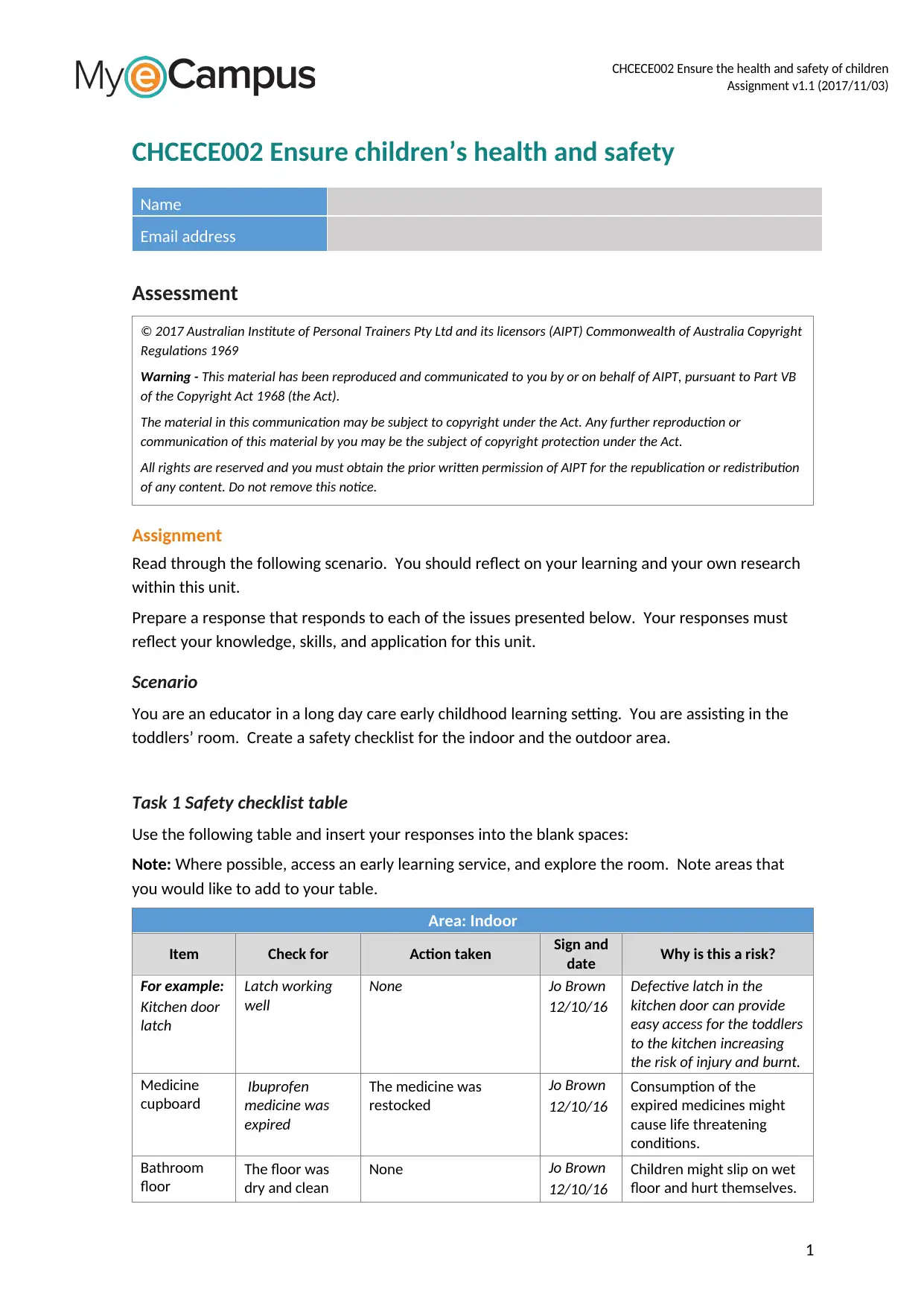
CHCECE002 Ensure the health and safety of children
Assignment v1.1 (2017/11/03)
CHCECE002 Ensure children’s health and safety
Name
Email address
Assessment
© 2017 Australian Institute of Personal Trainers Pty Ltd and its licensors (AIPT) Commonwealth of Australia Copyright
Regulations 1969
Warning - This material has been reproduced and communicated to you by or on behalf of AIPT, pursuant to Part VB
of the Copyright Act 1968 (the Act).
The material in this communication may be subject to copyright under the Act. Any further reproduction or
communication of this material by you may be the subject of copyright protection under the Act.
All rights are reserved and you must obtain the prior written permission of AIPT for the republication or redistribution
of any content. Do not remove this notice.
Assignment
Read through the following scenario. You should reflect on your learning and your own research
within this unit.
Prepare a response that responds to each of the issues presented below. Your responses must
reflect your knowledge, skills, and application for this unit.
Scenario
You are an educator in a long day care early childhood learning setting. You are assisting in the
toddlers’ room. Create a safety checklist for the indoor and the outdoor area.
Task 1 Safety checklist table
Use the following table and insert your responses into the blank spaces:
Note: Where possible, access an early learning service, and explore the room. Note areas that
you would like to add to your table.
Area: Indoor
Item Check for Action taken Sign and
date Why is this a risk?
For example:
Kitchen door
latch
Latch working
well
None Jo Brown
12/10/16
Defective latch in the
kitchen door can provide
easy access for the toddlers
to the kitchen increasing
the risk of injury and burnt.
Medicine
cupboard
Ibuprofen
medicine was
expired
The medicine was
restocked
Jo Brown
12/10/16
Consumption of the
expired medicines might
cause life threatening
conditions.
Bathroom
floor
The floor was
dry and clean
None Jo Brown
12/10/16
Children might slip on wet
floor and hurt themselves.
1
Assignment v1.1 (2017/11/03)
CHCECE002 Ensure children’s health and safety
Name
Email address
Assessment
© 2017 Australian Institute of Personal Trainers Pty Ltd and its licensors (AIPT) Commonwealth of Australia Copyright
Regulations 1969
Warning - This material has been reproduced and communicated to you by or on behalf of AIPT, pursuant to Part VB
of the Copyright Act 1968 (the Act).
The material in this communication may be subject to copyright under the Act. Any further reproduction or
communication of this material by you may be the subject of copyright protection under the Act.
All rights are reserved and you must obtain the prior written permission of AIPT for the republication or redistribution
of any content. Do not remove this notice.
Assignment
Read through the following scenario. You should reflect on your learning and your own research
within this unit.
Prepare a response that responds to each of the issues presented below. Your responses must
reflect your knowledge, skills, and application for this unit.
Scenario
You are an educator in a long day care early childhood learning setting. You are assisting in the
toddlers’ room. Create a safety checklist for the indoor and the outdoor area.
Task 1 Safety checklist table
Use the following table and insert your responses into the blank spaces:
Note: Where possible, access an early learning service, and explore the room. Note areas that
you would like to add to your table.
Area: Indoor
Item Check for Action taken Sign and
date Why is this a risk?
For example:
Kitchen door
latch
Latch working
well
None Jo Brown
12/10/16
Defective latch in the
kitchen door can provide
easy access for the toddlers
to the kitchen increasing
the risk of injury and burnt.
Medicine
cupboard
Ibuprofen
medicine was
expired
The medicine was
restocked
Jo Brown
12/10/16
Consumption of the
expired medicines might
cause life threatening
conditions.
Bathroom
floor
The floor was
dry and clean
None Jo Brown
12/10/16
Children might slip on wet
floor and hurt themselves.
1
Secure Best Marks with AI Grader
Need help grading? Try our AI Grader for instant feedback on your assignments.
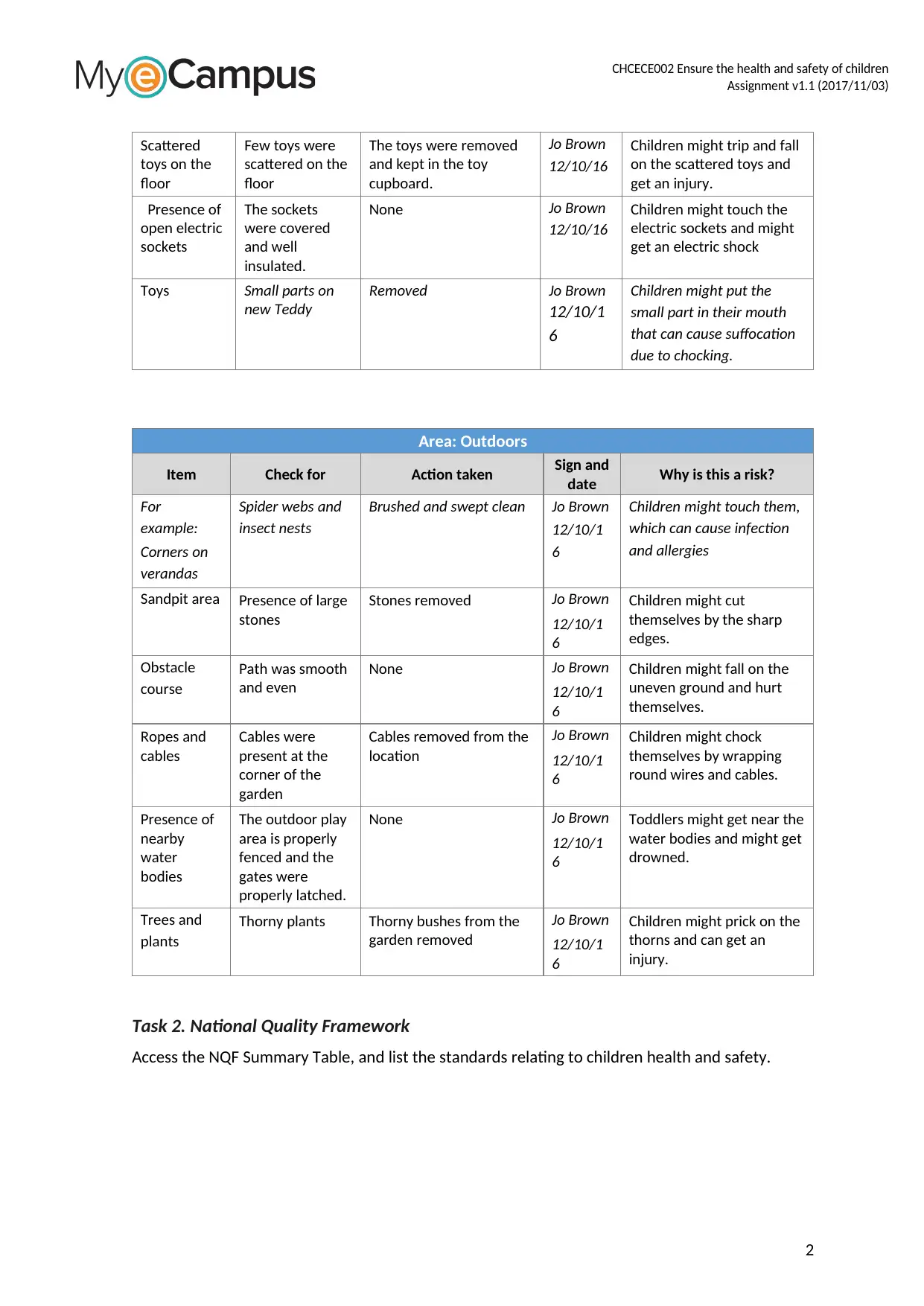
CHCECE002 Ensure the health and safety of children
Assignment v1.1 (2017/11/03)
Scattered
toys on the
floor
Few toys were
scattered on the
floor
The toys were removed
and kept in the toy
cupboard.
Jo Brown
12/10/16
Children might trip and fall
on the scattered toys and
get an injury.
Presence of
open electric
sockets
The sockets
were covered
and well
insulated.
None Jo Brown
12/10/16
Children might touch the
electric sockets and might
get an electric shock
Toys Small parts on
new Teddy
Removed Jo Brown
12/10/1
6
Children might put the
small part in their mouth
that can cause suffocation
due to chocking.
Area: Outdoors
Item Check for Action taken Sign and
date Why is this a risk?
For
example:
Corners on
verandas
Spider webs and
insect nests
Brushed and swept clean Jo Brown
12/10/1
6
Children might touch them,
which can cause infection
and allergies
Sandpit area Presence of large
stones
Stones removed Jo Brown
12/10/1
6
Children might cut
themselves by the sharp
edges.
Obstacle
course
Path was smooth
and even
None Jo Brown
12/10/1
6
Children might fall on the
uneven ground and hurt
themselves.
Ropes and
cables
Cables were
present at the
corner of the
garden
Cables removed from the
location
Jo Brown
12/10/1
6
Children might chock
themselves by wrapping
round wires and cables.
Presence of
nearby
water
bodies
The outdoor play
area is properly
fenced and the
gates were
properly latched.
None Jo Brown
12/10/1
6
Toddlers might get near the
water bodies and might get
drowned.
Trees and
plants
Thorny plants Thorny bushes from the
garden removed
Jo Brown
12/10/1
6
Children might prick on the
thorns and can get an
injury.
Task 2. National Quality Framework
Access the NQF Summary Table, and list the standards relating to children health and safety.
2
Assignment v1.1 (2017/11/03)
Scattered
toys on the
floor
Few toys were
scattered on the
floor
The toys were removed
and kept in the toy
cupboard.
Jo Brown
12/10/16
Children might trip and fall
on the scattered toys and
get an injury.
Presence of
open electric
sockets
The sockets
were covered
and well
insulated.
None Jo Brown
12/10/16
Children might touch the
electric sockets and might
get an electric shock
Toys Small parts on
new Teddy
Removed Jo Brown
12/10/1
6
Children might put the
small part in their mouth
that can cause suffocation
due to chocking.
Area: Outdoors
Item Check for Action taken Sign and
date Why is this a risk?
For
example:
Corners on
verandas
Spider webs and
insect nests
Brushed and swept clean Jo Brown
12/10/1
6
Children might touch them,
which can cause infection
and allergies
Sandpit area Presence of large
stones
Stones removed Jo Brown
12/10/1
6
Children might cut
themselves by the sharp
edges.
Obstacle
course
Path was smooth
and even
None Jo Brown
12/10/1
6
Children might fall on the
uneven ground and hurt
themselves.
Ropes and
cables
Cables were
present at the
corner of the
garden
Cables removed from the
location
Jo Brown
12/10/1
6
Children might chock
themselves by wrapping
round wires and cables.
Presence of
nearby
water
bodies
The outdoor play
area is properly
fenced and the
gates were
properly latched.
None Jo Brown
12/10/1
6
Toddlers might get near the
water bodies and might get
drowned.
Trees and
plants
Thorny plants Thorny bushes from the
garden removed
Jo Brown
12/10/1
6
Children might prick on the
thorns and can get an
injury.
Task 2. National Quality Framework
Access the NQF Summary Table, and list the standards relating to children health and safety.
2
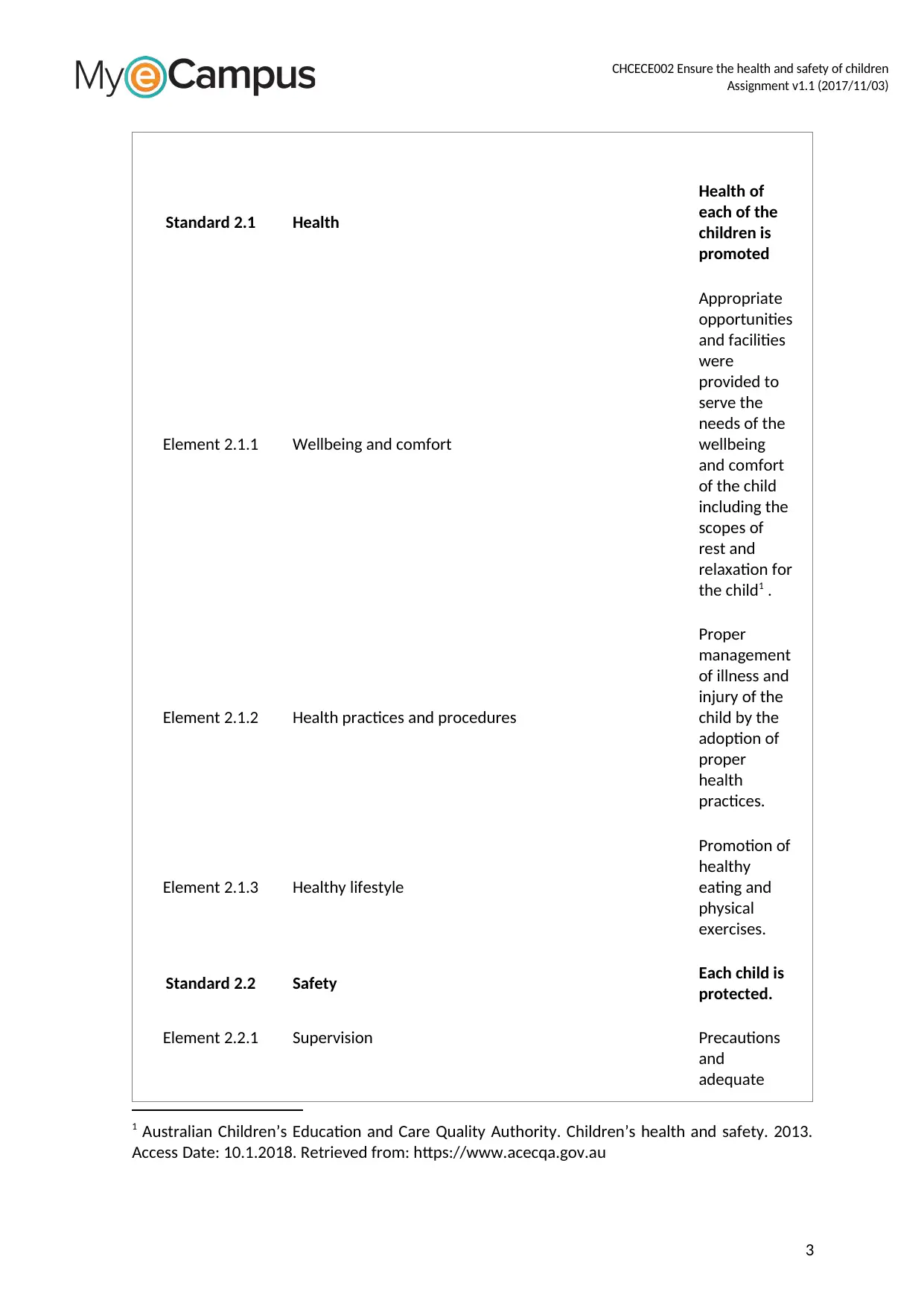
CHCECE002 Ensure the health and safety of children
Assignment v1.1 (2017/11/03)
Standard 2.1 Health
Health of
each of the
children is
promoted
Element 2.1.1 Wellbeing and comfort
Appropriate
opportunities
and facilities
were
provided to
serve the
needs of the
wellbeing
and comfort
of the child
including the
scopes of
rest and
relaxation for
the child1 .
Element 2.1.2 Health practices and procedures
Proper
management
of illness and
injury of the
child by the
adoption of
proper
health
practices.
Element 2.1.3 Healthy lifestyle
Promotion of
healthy
eating and
physical
exercises.
Standard 2.2 Safety Each child is
protected.
Element 2.2.1 Supervision Precautions
and
adequate
1 Australian Children’s Education and Care Quality Authority. Children’s health and safety. 2013.
Access Date: 10.1.2018. Retrieved from: https://www.acecqa.gov.au
3
Assignment v1.1 (2017/11/03)
Standard 2.1 Health
Health of
each of the
children is
promoted
Element 2.1.1 Wellbeing and comfort
Appropriate
opportunities
and facilities
were
provided to
serve the
needs of the
wellbeing
and comfort
of the child
including the
scopes of
rest and
relaxation for
the child1 .
Element 2.1.2 Health practices and procedures
Proper
management
of illness and
injury of the
child by the
adoption of
proper
health
practices.
Element 2.1.3 Healthy lifestyle
Promotion of
healthy
eating and
physical
exercises.
Standard 2.2 Safety Each child is
protected.
Element 2.2.1 Supervision Precautions
and
adequate
1 Australian Children’s Education and Care Quality Authority. Children’s health and safety. 2013.
Access Date: 10.1.2018. Retrieved from: https://www.acecqa.gov.au
3
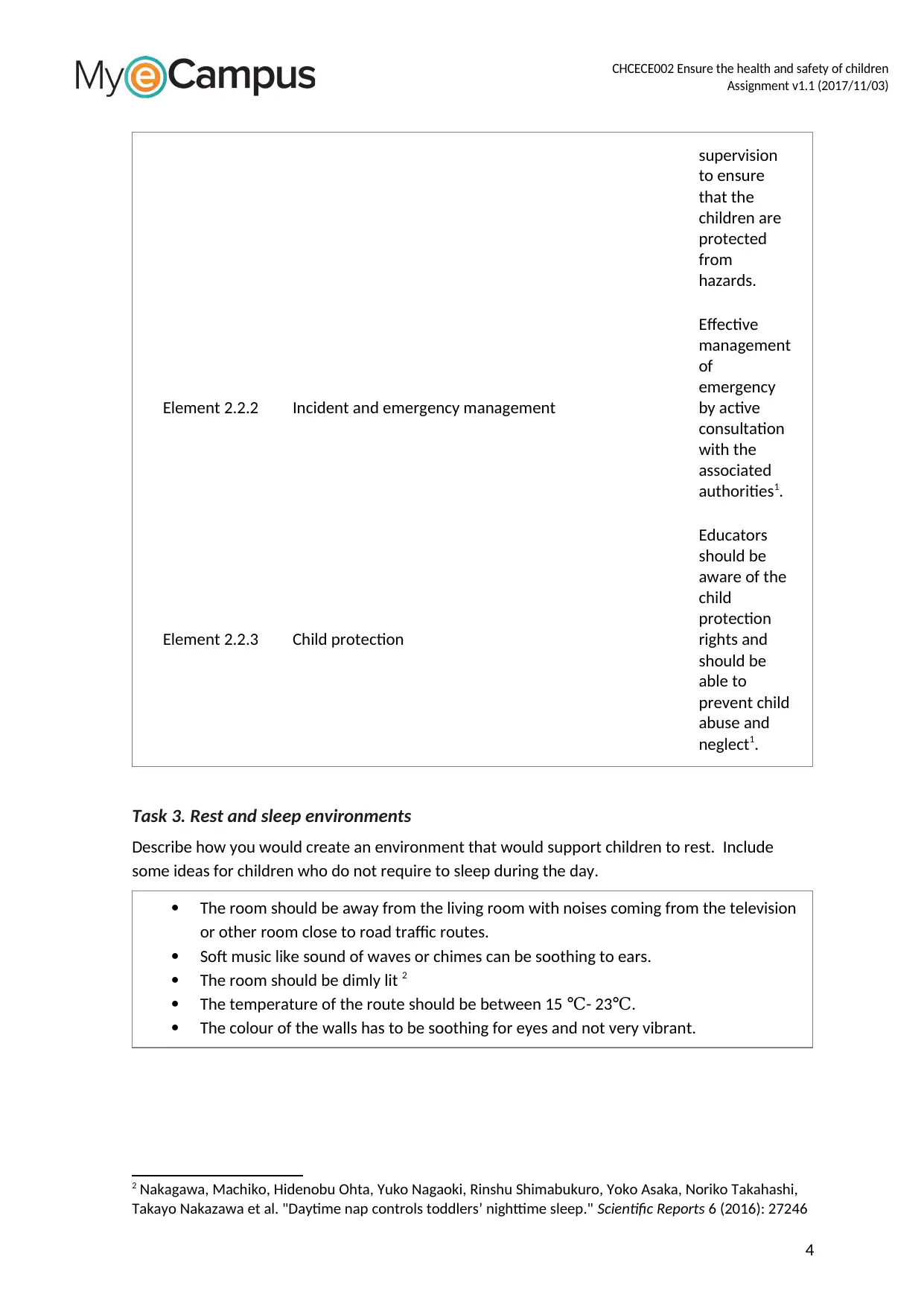
CHCECE002 Ensure the health and safety of children
Assignment v1.1 (2017/11/03)
supervision
to ensure
that the
children are
protected
from
hazards.
Element 2.2.2 Incident and emergency management
Effective
management
of
emergency
by active
consultation
with the
associated
authorities1.
Element 2.2.3 Child protection
Educators
should be
aware of the
child
protection
rights and
should be
able to
prevent child
abuse and
neglect1.
Task 3. Rest and sleep environments
Describe how you would create an environment that would support children to rest. Include
some ideas for children who do not require to sleep during the day.
The room should be away from the living room with noises coming from the television
or other room close to road traffic routes.
Soft music like sound of waves or chimes can be soothing to ears.
The room should be dimly lit 2
The temperature of the route should be between 15 ℃- 23℃.
The colour of the walls has to be soothing for eyes and not very vibrant.
2 Nakagawa, Machiko, Hidenobu Ohta, Yuko Nagaoki, Rinshu Shimabukuro, Yoko Asaka, Noriko Takahashi,
Takayo Nakazawa et al. "Daytime nap controls toddlers’ nighttime sleep." Scientific Reports 6 (2016): 27246
4
Assignment v1.1 (2017/11/03)
supervision
to ensure
that the
children are
protected
from
hazards.
Element 2.2.2 Incident and emergency management
Effective
management
of
emergency
by active
consultation
with the
associated
authorities1.
Element 2.2.3 Child protection
Educators
should be
aware of the
child
protection
rights and
should be
able to
prevent child
abuse and
neglect1.
Task 3. Rest and sleep environments
Describe how you would create an environment that would support children to rest. Include
some ideas for children who do not require to sleep during the day.
The room should be away from the living room with noises coming from the television
or other room close to road traffic routes.
Soft music like sound of waves or chimes can be soothing to ears.
The room should be dimly lit 2
The temperature of the route should be between 15 ℃- 23℃.
The colour of the walls has to be soothing for eyes and not very vibrant.
2 Nakagawa, Machiko, Hidenobu Ohta, Yuko Nagaoki, Rinshu Shimabukuro, Yoko Asaka, Noriko Takahashi,
Takayo Nakazawa et al. "Daytime nap controls toddlers’ nighttime sleep." Scientific Reports 6 (2016): 27246
4
Secure Best Marks with AI Grader
Need help grading? Try our AI Grader for instant feedback on your assignments.
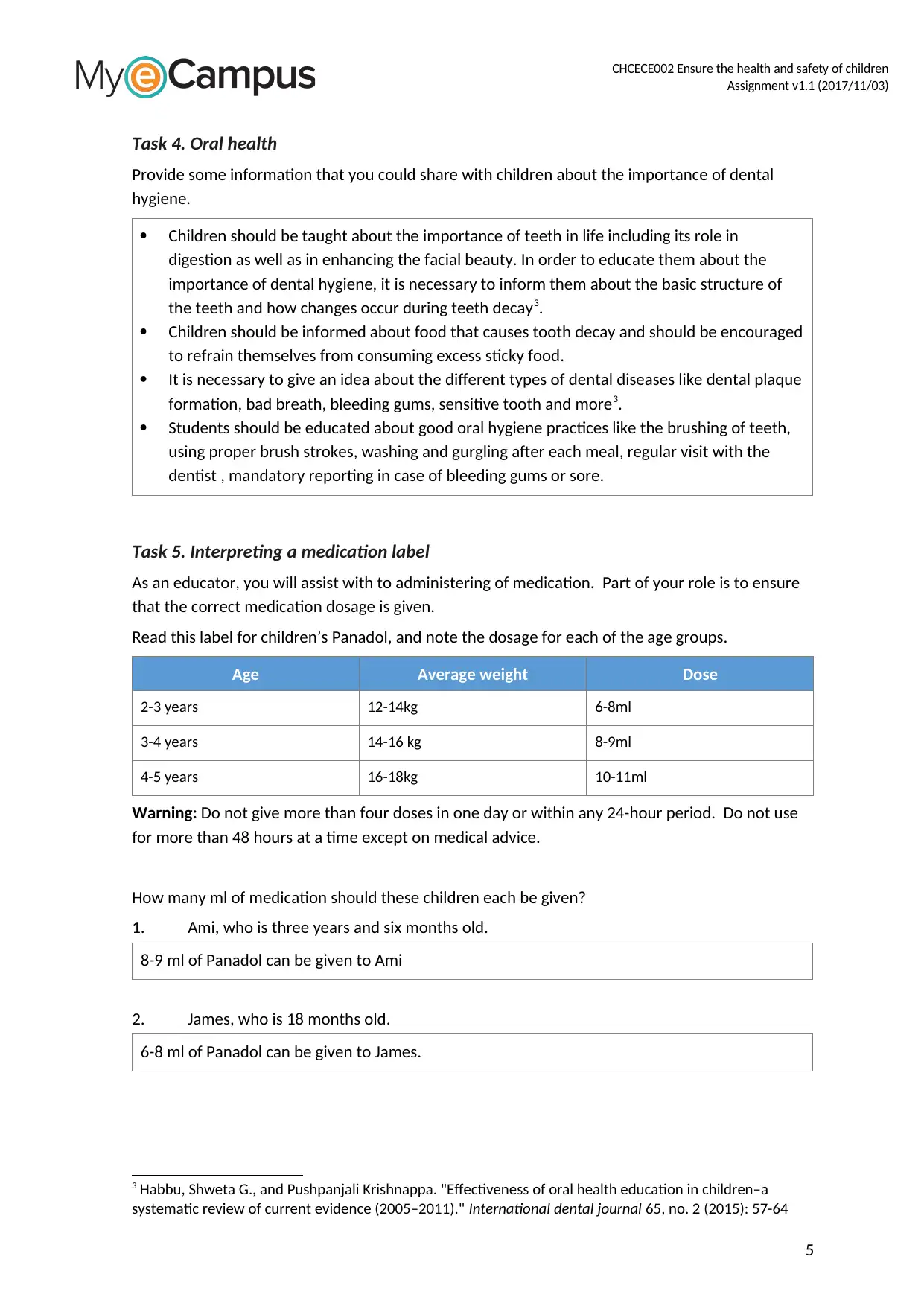
CHCECE002 Ensure the health and safety of children
Assignment v1.1 (2017/11/03)
Task 4. Oral health
Provide some information that you could share with children about the importance of dental
hygiene.
Children should be taught about the importance of teeth in life including its role in
digestion as well as in enhancing the facial beauty. In order to educate them about the
importance of dental hygiene, it is necessary to inform them about the basic structure of
the teeth and how changes occur during teeth decay3.
Children should be informed about food that causes tooth decay and should be encouraged
to refrain themselves from consuming excess sticky food.
It is necessary to give an idea about the different types of dental diseases like dental plaque
formation, bad breath, bleeding gums, sensitive tooth and more3.
Students should be educated about good oral hygiene practices like the brushing of teeth,
using proper brush strokes, washing and gurgling after each meal, regular visit with the
dentist , mandatory reporting in case of bleeding gums or sore.
Task 5. Interpreting a medication label
As an educator, you will assist with to administering of medication. Part of your role is to ensure
that the correct medication dosage is given.
Read this label for children’s Panadol, and note the dosage for each of the age groups.
Age Average weight Dose
2-3 years 12-14kg 6-8ml
3-4 years 14-16 kg 8-9ml
4-5 years 16-18kg 10-11ml
Warning: Do not give more than four doses in one day or within any 24-hour period. Do not use
for more than 48 hours at a time except on medical advice.
How many ml of medication should these children each be given?
1. Ami, who is three years and six months old.
8-9 ml of Panadol can be given to Ami
2. James, who is 18 months old.
6-8 ml of Panadol can be given to James.
3 Habbu, Shweta G., and Pushpanjali Krishnappa. "Effectiveness of oral health education in children–a
systematic review of current evidence (2005–2011)." International dental journal 65, no. 2 (2015): 57-64
5
Assignment v1.1 (2017/11/03)
Task 4. Oral health
Provide some information that you could share with children about the importance of dental
hygiene.
Children should be taught about the importance of teeth in life including its role in
digestion as well as in enhancing the facial beauty. In order to educate them about the
importance of dental hygiene, it is necessary to inform them about the basic structure of
the teeth and how changes occur during teeth decay3.
Children should be informed about food that causes tooth decay and should be encouraged
to refrain themselves from consuming excess sticky food.
It is necessary to give an idea about the different types of dental diseases like dental plaque
formation, bad breath, bleeding gums, sensitive tooth and more3.
Students should be educated about good oral hygiene practices like the brushing of teeth,
using proper brush strokes, washing and gurgling after each meal, regular visit with the
dentist , mandatory reporting in case of bleeding gums or sore.
Task 5. Interpreting a medication label
As an educator, you will assist with to administering of medication. Part of your role is to ensure
that the correct medication dosage is given.
Read this label for children’s Panadol, and note the dosage for each of the age groups.
Age Average weight Dose
2-3 years 12-14kg 6-8ml
3-4 years 14-16 kg 8-9ml
4-5 years 16-18kg 10-11ml
Warning: Do not give more than four doses in one day or within any 24-hour period. Do not use
for more than 48 hours at a time except on medical advice.
How many ml of medication should these children each be given?
1. Ami, who is three years and six months old.
8-9 ml of Panadol can be given to Ami
2. James, who is 18 months old.
6-8 ml of Panadol can be given to James.
3 Habbu, Shweta G., and Pushpanjali Krishnappa. "Effectiveness of oral health education in children–a
systematic review of current evidence (2005–2011)." International dental journal 65, no. 2 (2015): 57-64
5
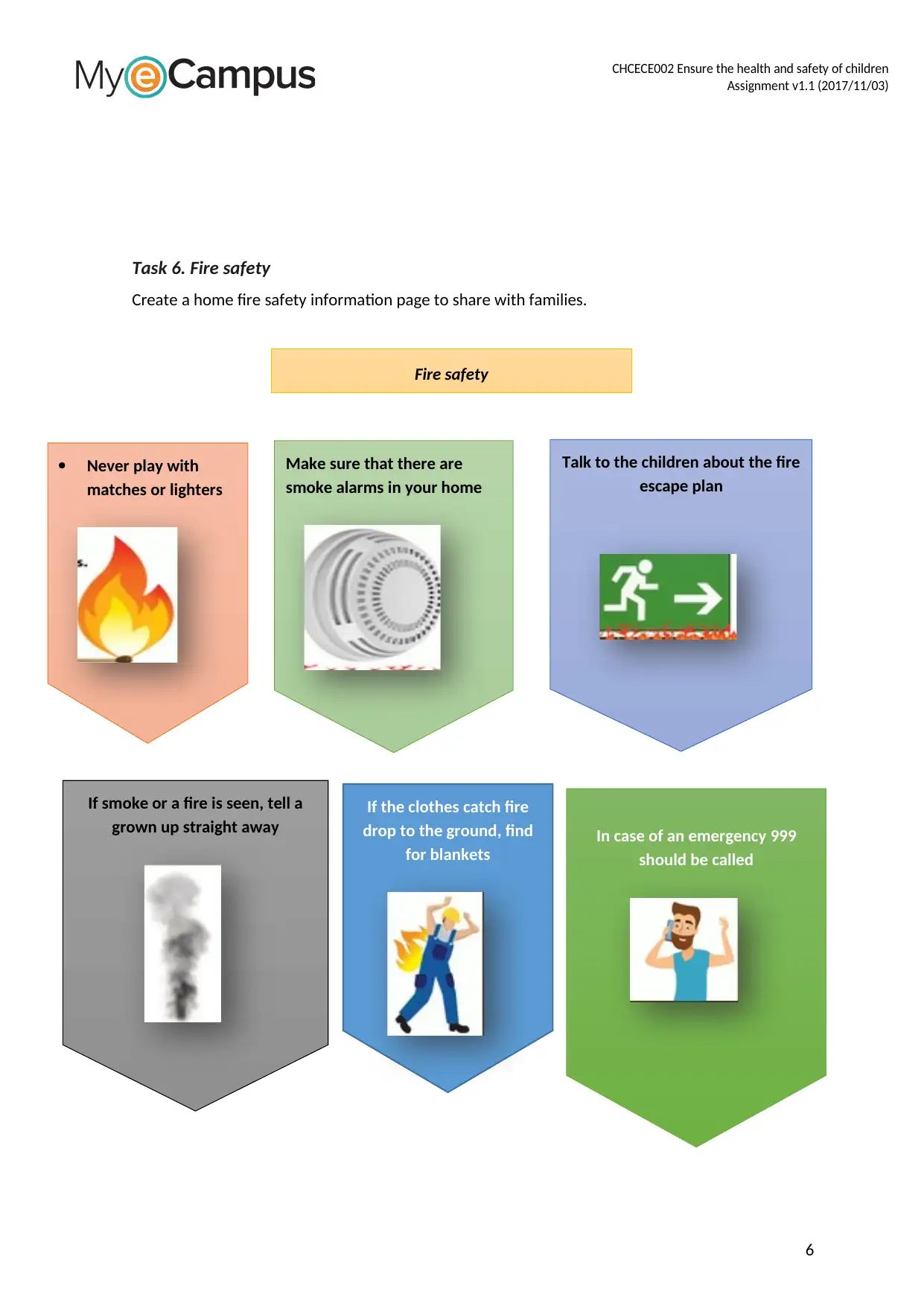
CHCECE002 Ensure the health and safety of children
Assignment v1.1 (2017/11/03)
Task 6. Fire safety
Create a home fire safety information page to share with families.
6
Fire safety
Never play with
matches or lighters
Make sure that there are
smoke alarms in your home
Talk to the children about the fire
escape plan
In case of an emergency 999
should be called
If the clothes catch fire
drop to the ground, find
for blankets
If smoke or a fire is seen, tell a
grown up straight away
Assignment v1.1 (2017/11/03)
Task 6. Fire safety
Create a home fire safety information page to share with families.
6
Fire safety
Never play with
matches or lighters
Make sure that there are
smoke alarms in your home
Talk to the children about the fire
escape plan
In case of an emergency 999
should be called
If the clothes catch fire
drop to the ground, find
for blankets
If smoke or a fire is seen, tell a
grown up straight away
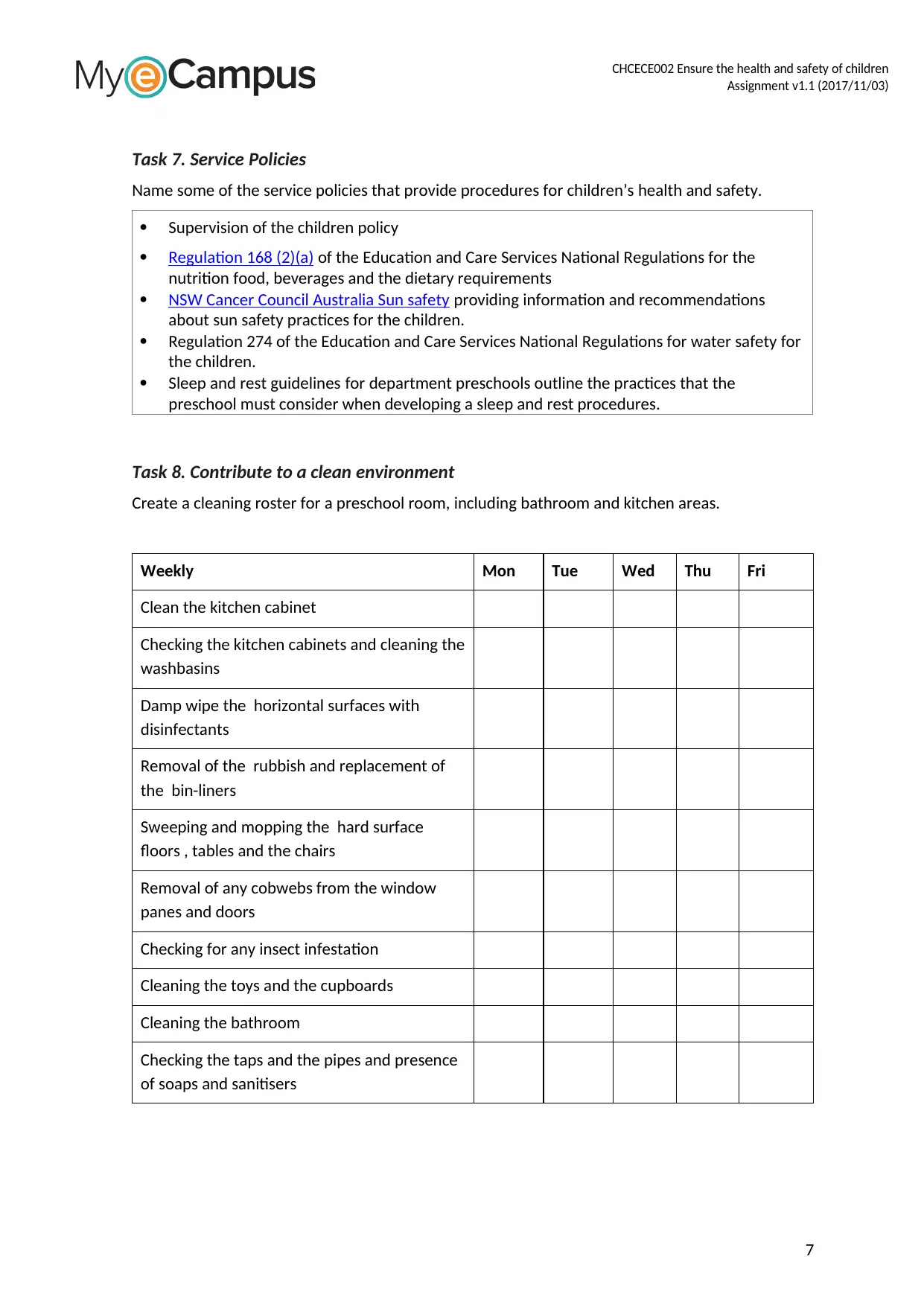
CHCECE002 Ensure the health and safety of children
Assignment v1.1 (2017/11/03)
Task 7. Service Policies
Name some of the service policies that provide procedures for children’s health and safety.
Supervision of the children policy
Regulation 168 (2)(a) of the Education and Care Services National Regulations for the
nutrition food, beverages and the dietary requirements
NSW Cancer Council Australia Sun safety providing information and recommendations
about sun safety practices for the children.
Regulation 274 of the Education and Care Services National Regulations for water safety for
the children.
Sleep and rest guidelines for department preschools outline the practices that the
preschool must consider when developing a sleep and rest procedures.
Task 8. Contribute to a clean environment
Create a cleaning roster for a preschool room, including bathroom and kitchen areas.
Weekly Mon Tue Wed Thu Fri
Clean the kitchen cabinet
Checking the kitchen cabinets and cleaning the
washbasins
Damp wipe the horizontal surfaces with
disinfectants
Removal of the rubbish and replacement of
the bin-liners
Sweeping and mopping the hard surface
floors , tables and the chairs
Removal of any cobwebs from the window
panes and doors
Checking for any insect infestation
Cleaning the toys and the cupboards
Cleaning the bathroom
Checking the taps and the pipes and presence
of soaps and sanitisers
7
Assignment v1.1 (2017/11/03)
Task 7. Service Policies
Name some of the service policies that provide procedures for children’s health and safety.
Supervision of the children policy
Regulation 168 (2)(a) of the Education and Care Services National Regulations for the
nutrition food, beverages and the dietary requirements
NSW Cancer Council Australia Sun safety providing information and recommendations
about sun safety practices for the children.
Regulation 274 of the Education and Care Services National Regulations for water safety for
the children.
Sleep and rest guidelines for department preschools outline the practices that the
preschool must consider when developing a sleep and rest procedures.
Task 8. Contribute to a clean environment
Create a cleaning roster for a preschool room, including bathroom and kitchen areas.
Weekly Mon Tue Wed Thu Fri
Clean the kitchen cabinet
Checking the kitchen cabinets and cleaning the
washbasins
Damp wipe the horizontal surfaces with
disinfectants
Removal of the rubbish and replacement of
the bin-liners
Sweeping and mopping the hard surface
floors , tables and the chairs
Removal of any cobwebs from the window
panes and doors
Checking for any insect infestation
Cleaning the toys and the cupboards
Cleaning the bathroom
Checking the taps and the pipes and presence
of soaps and sanitisers
7
Paraphrase This Document
Need a fresh take? Get an instant paraphrase of this document with our AI Paraphraser
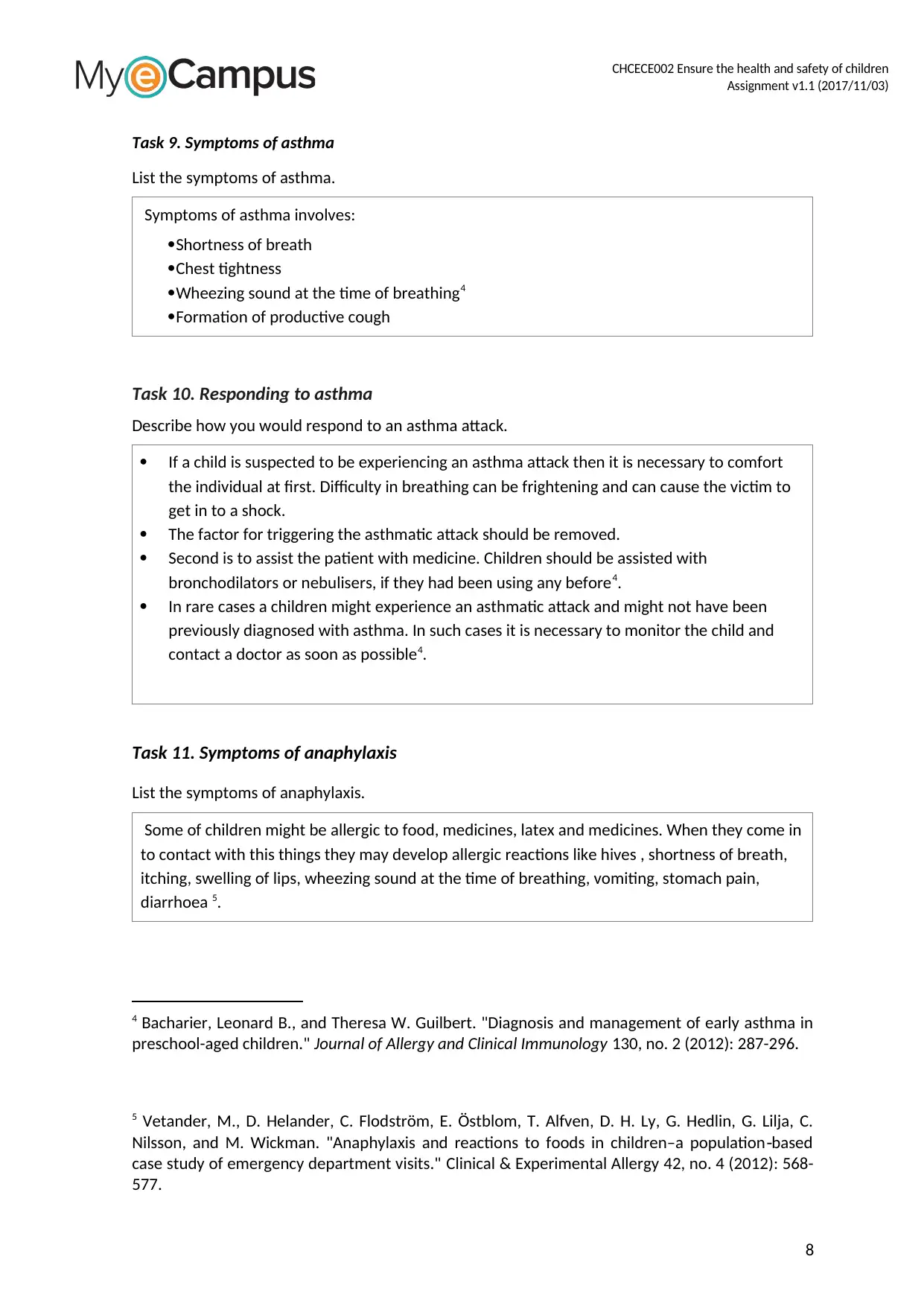
CHCECE002 Ensure the health and safety of children
Assignment v1.1 (2017/11/03)
Task 9. Symptoms of asthma
List the symptoms of asthma.
Symptoms of asthma involves:
Shortness of breath
Chest tightness
Wheezing sound at the time of breathing4
Formation of productive cough
Task 10. Responding to asthma
Describe how you would respond to an asthma attack.
If a child is suspected to be experiencing an asthma attack then it is necessary to comfort
the individual at first. Difficulty in breathing can be frightening and can cause the victim to
get in to a shock.
The factor for triggering the asthmatic attack should be removed.
Second is to assist the patient with medicine. Children should be assisted with
bronchodilators or nebulisers, if they had been using any before4.
In rare cases a children might experience an asthmatic attack and might not have been
previously diagnosed with asthma. In such cases it is necessary to monitor the child and
contact a doctor as soon as possible4.
Task 11. Symptoms of anaphylaxis
List the symptoms of anaphylaxis.
Some of children might be allergic to food, medicines, latex and medicines. When they come in
to contact with this things they may develop allergic reactions like hives , shortness of breath,
itching, swelling of lips, wheezing sound at the time of breathing, vomiting, stomach pain,
diarrhoea 5.
4 Bacharier, Leonard B., and Theresa W. Guilbert. "Diagnosis and management of early asthma in
preschool-aged children." Journal of Allergy and Clinical Immunology 130, no. 2 (2012): 287-296.
5 Vetander, M., D. Helander, C. Flodström, E. Östblom, T. Alfven, D. H. Ly, G. Hedlin, G. Lilja, C.
Nilsson, and M. Wickman. "Anaphylaxis and reactions to foods in children–a population based‐
case study of emergency department visits." Clinical & Experimental Allergy 42, no. 4 (2012): 568-
577.
8
Assignment v1.1 (2017/11/03)
Task 9. Symptoms of asthma
List the symptoms of asthma.
Symptoms of asthma involves:
Shortness of breath
Chest tightness
Wheezing sound at the time of breathing4
Formation of productive cough
Task 10. Responding to asthma
Describe how you would respond to an asthma attack.
If a child is suspected to be experiencing an asthma attack then it is necessary to comfort
the individual at first. Difficulty in breathing can be frightening and can cause the victim to
get in to a shock.
The factor for triggering the asthmatic attack should be removed.
Second is to assist the patient with medicine. Children should be assisted with
bronchodilators or nebulisers, if they had been using any before4.
In rare cases a children might experience an asthmatic attack and might not have been
previously diagnosed with asthma. In such cases it is necessary to monitor the child and
contact a doctor as soon as possible4.
Task 11. Symptoms of anaphylaxis
List the symptoms of anaphylaxis.
Some of children might be allergic to food, medicines, latex and medicines. When they come in
to contact with this things they may develop allergic reactions like hives , shortness of breath,
itching, swelling of lips, wheezing sound at the time of breathing, vomiting, stomach pain,
diarrhoea 5.
4 Bacharier, Leonard B., and Theresa W. Guilbert. "Diagnosis and management of early asthma in
preschool-aged children." Journal of Allergy and Clinical Immunology 130, no. 2 (2012): 287-296.
5 Vetander, M., D. Helander, C. Flodström, E. Östblom, T. Alfven, D. H. Ly, G. Hedlin, G. Lilja, C.
Nilsson, and M. Wickman. "Anaphylaxis and reactions to foods in children–a population based‐
case study of emergency department visits." Clinical & Experimental Allergy 42, no. 4 (2012): 568-
577.
8

CHCECE002 Ensure the health and safety of children
Assignment v1.1 (2017/11/03)
Task 12. How do you need to respond to anaphylaxis
Describe how you would respond to a possible anaphylaxis reaction.
In case a child suffers from an anaphylactic reaction, it is essential to take the child to the
nearest emergency department. If the child has an emergency allergic medication like
epinephrine, then it is to be given right away. In case the child is having a breathing trouble, no
medication should be given if the child is having trouble breathing5. It is necessary to calm and
reassure the child as panic attack might worsen the conditions if the child is suffering from
shortness of breath. It is necessary to check the airway and the breathing. In case of severe
breathing trouble, Cardiopulmonary resuscitation might has to be done for restoring blood
circulation. The child should be laid flat on the ground. Cushions or pillows can be kept for
keeping the feet of the child, raised above the level of the heart5.
Task 13. Children’s awareness of safety
Provide some ways you could introduce children to the need for safe behaviour
A child should be taught about the protective behaviours, their bodies and the personal
boundaries. It can be initiated by naming the body parts and explaining to them, the purpose of
each part and what will happen if they get injured and explain to them the possible ways by
which they can get injured. Children should be encouraged to trust their instincts and
understand the safe and the not safe touches. Mandatory reporting should be taught to the
children such that they report abuse, neglect or any other kind of harm6.
If the child has got knowledge about numbers he/she could be taught about the emergency
service numbers. The child can be encouraged to write the names of the family members that
has to be contacted first and in case of an emergency6.
Task 14. Fire exits
Why should fire exits be kept clear at all times? How can this be done?
The fire exits should always be kept clear for ensuring that everyone can exit the building in
the event of any fire or emergency.
Each and every schools and workplaces should have a clearly identified means of fire that
should be kept clear all the time. A notice board should be hanged before the escape door for
the easy identification. The exit spaces has to be spacious enough to accommodate the
evacuation process. Generally the escape routes should be at least one metre wide. Fire
detection, emergency lighting and emergency egress has to be addressed. The escape route
should lead to safe place normally outside the building. All the routes should be kept clear,
including the areas outside the premises that are involved in the exit7. The doors of the fire
6 Government of South Australia. CHILD SAFE ENVIRONMENT Policies and Procedures. 2012.
Retrieved from: http://www.balaklavacc.sa.edu.au
7 Australian Government. Fire safety .2014. Access Date: 10.1.2018. Retrieved from:
9
Assignment v1.1 (2017/11/03)
Task 12. How do you need to respond to anaphylaxis
Describe how you would respond to a possible anaphylaxis reaction.
In case a child suffers from an anaphylactic reaction, it is essential to take the child to the
nearest emergency department. If the child has an emergency allergic medication like
epinephrine, then it is to be given right away. In case the child is having a breathing trouble, no
medication should be given if the child is having trouble breathing5. It is necessary to calm and
reassure the child as panic attack might worsen the conditions if the child is suffering from
shortness of breath. It is necessary to check the airway and the breathing. In case of severe
breathing trouble, Cardiopulmonary resuscitation might has to be done for restoring blood
circulation. The child should be laid flat on the ground. Cushions or pillows can be kept for
keeping the feet of the child, raised above the level of the heart5.
Task 13. Children’s awareness of safety
Provide some ways you could introduce children to the need for safe behaviour
A child should be taught about the protective behaviours, their bodies and the personal
boundaries. It can be initiated by naming the body parts and explaining to them, the purpose of
each part and what will happen if they get injured and explain to them the possible ways by
which they can get injured. Children should be encouraged to trust their instincts and
understand the safe and the not safe touches. Mandatory reporting should be taught to the
children such that they report abuse, neglect or any other kind of harm6.
If the child has got knowledge about numbers he/she could be taught about the emergency
service numbers. The child can be encouraged to write the names of the family members that
has to be contacted first and in case of an emergency6.
Task 14. Fire exits
Why should fire exits be kept clear at all times? How can this be done?
The fire exits should always be kept clear for ensuring that everyone can exit the building in
the event of any fire or emergency.
Each and every schools and workplaces should have a clearly identified means of fire that
should be kept clear all the time. A notice board should be hanged before the escape door for
the easy identification. The exit spaces has to be spacious enough to accommodate the
evacuation process. Generally the escape routes should be at least one metre wide. Fire
detection, emergency lighting and emergency egress has to be addressed. The escape route
should lead to safe place normally outside the building. All the routes should be kept clear,
including the areas outside the premises that are involved in the exit7. The doors of the fire
6 Government of South Australia. CHILD SAFE ENVIRONMENT Policies and Procedures. 2012.
Retrieved from: http://www.balaklavacc.sa.edu.au
7 Australian Government. Fire safety .2014. Access Date: 10.1.2018. Retrieved from:
9
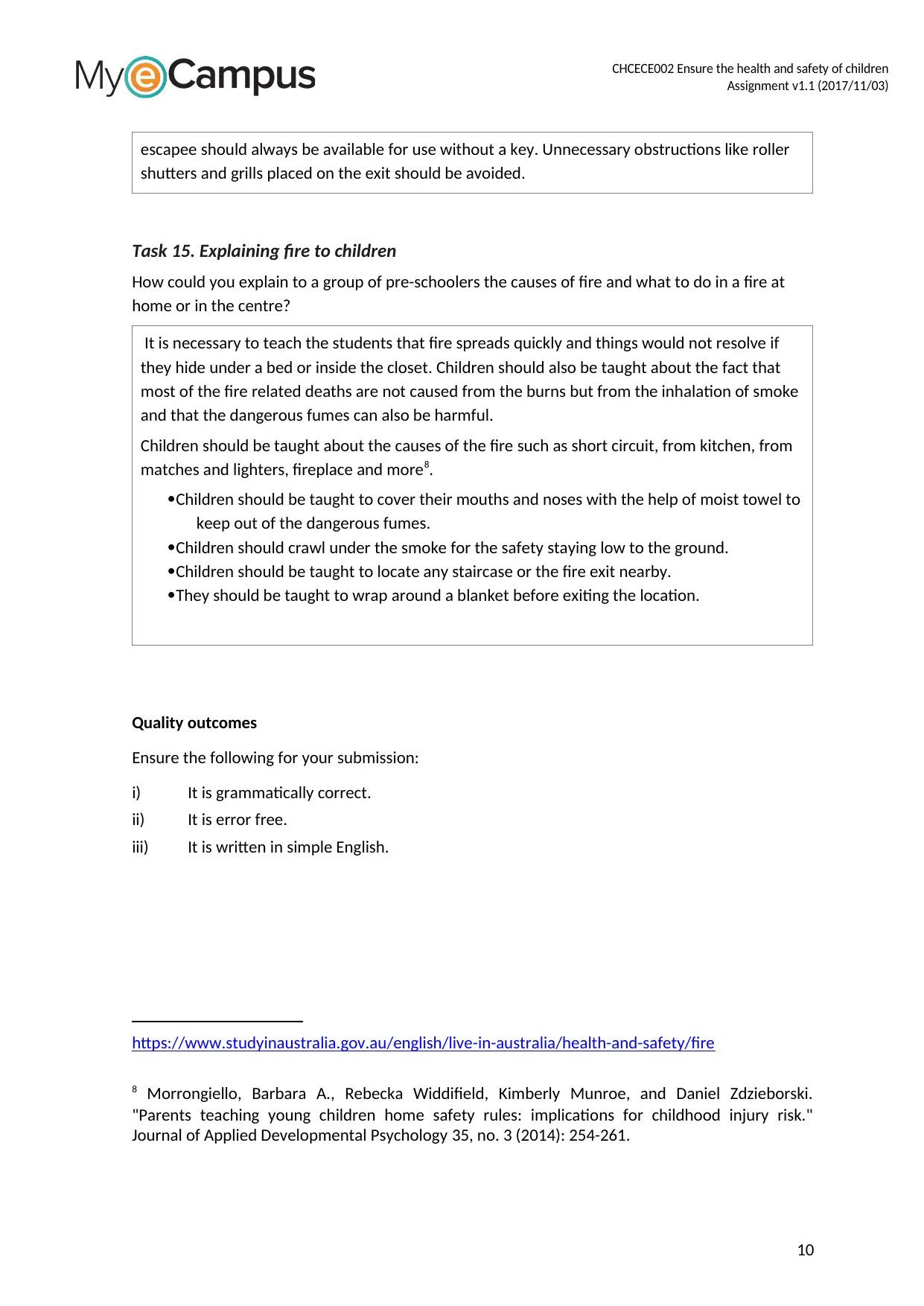
CHCECE002 Ensure the health and safety of children
Assignment v1.1 (2017/11/03)
escapee should always be available for use without a key. Unnecessary obstructions like roller
shutters and grills placed on the exit should be avoided.
Task 15. Explaining fire to children
How could you explain to a group of pre-schoolers the causes of fire and what to do in a fire at
home or in the centre?
It is necessary to teach the students that fire spreads quickly and things would not resolve if
they hide under a bed or inside the closet. Children should also be taught about the fact that
most of the fire related deaths are not caused from the burns but from the inhalation of smoke
and that the dangerous fumes can also be harmful.
Children should be taught about the causes of the fire such as short circuit, from kitchen, from
matches and lighters, fireplace and more8.
Children should be taught to cover their mouths and noses with the help of moist towel to
keep out of the dangerous fumes.
Children should crawl under the smoke for the safety staying low to the ground.
Children should be taught to locate any staircase or the fire exit nearby.
They should be taught to wrap around a blanket before exiting the location.
Quality outcomes
Ensure the following for your submission:
i) It is grammatically correct.
ii) It is error free.
iii) It is written in simple English.
https://www.studyinaustralia.gov.au/english/live-in-australia/health-and-safety/fire
8 Morrongiello, Barbara A., Rebecka Widdifield, Kimberly Munroe, and Daniel Zdzieborski.
"Parents teaching young children home safety rules: implications for childhood injury risk."
Journal of Applied Developmental Psychology 35, no. 3 (2014): 254-261.
10
Assignment v1.1 (2017/11/03)
escapee should always be available for use without a key. Unnecessary obstructions like roller
shutters and grills placed on the exit should be avoided.
Task 15. Explaining fire to children
How could you explain to a group of pre-schoolers the causes of fire and what to do in a fire at
home or in the centre?
It is necessary to teach the students that fire spreads quickly and things would not resolve if
they hide under a bed or inside the closet. Children should also be taught about the fact that
most of the fire related deaths are not caused from the burns but from the inhalation of smoke
and that the dangerous fumes can also be harmful.
Children should be taught about the causes of the fire such as short circuit, from kitchen, from
matches and lighters, fireplace and more8.
Children should be taught to cover their mouths and noses with the help of moist towel to
keep out of the dangerous fumes.
Children should crawl under the smoke for the safety staying low to the ground.
Children should be taught to locate any staircase or the fire exit nearby.
They should be taught to wrap around a blanket before exiting the location.
Quality outcomes
Ensure the following for your submission:
i) It is grammatically correct.
ii) It is error free.
iii) It is written in simple English.
https://www.studyinaustralia.gov.au/english/live-in-australia/health-and-safety/fire
8 Morrongiello, Barbara A., Rebecka Widdifield, Kimberly Munroe, and Daniel Zdzieborski.
"Parents teaching young children home safety rules: implications for childhood injury risk."
Journal of Applied Developmental Psychology 35, no. 3 (2014): 254-261.
10
Secure Best Marks with AI Grader
Need help grading? Try our AI Grader for instant feedback on your assignments.
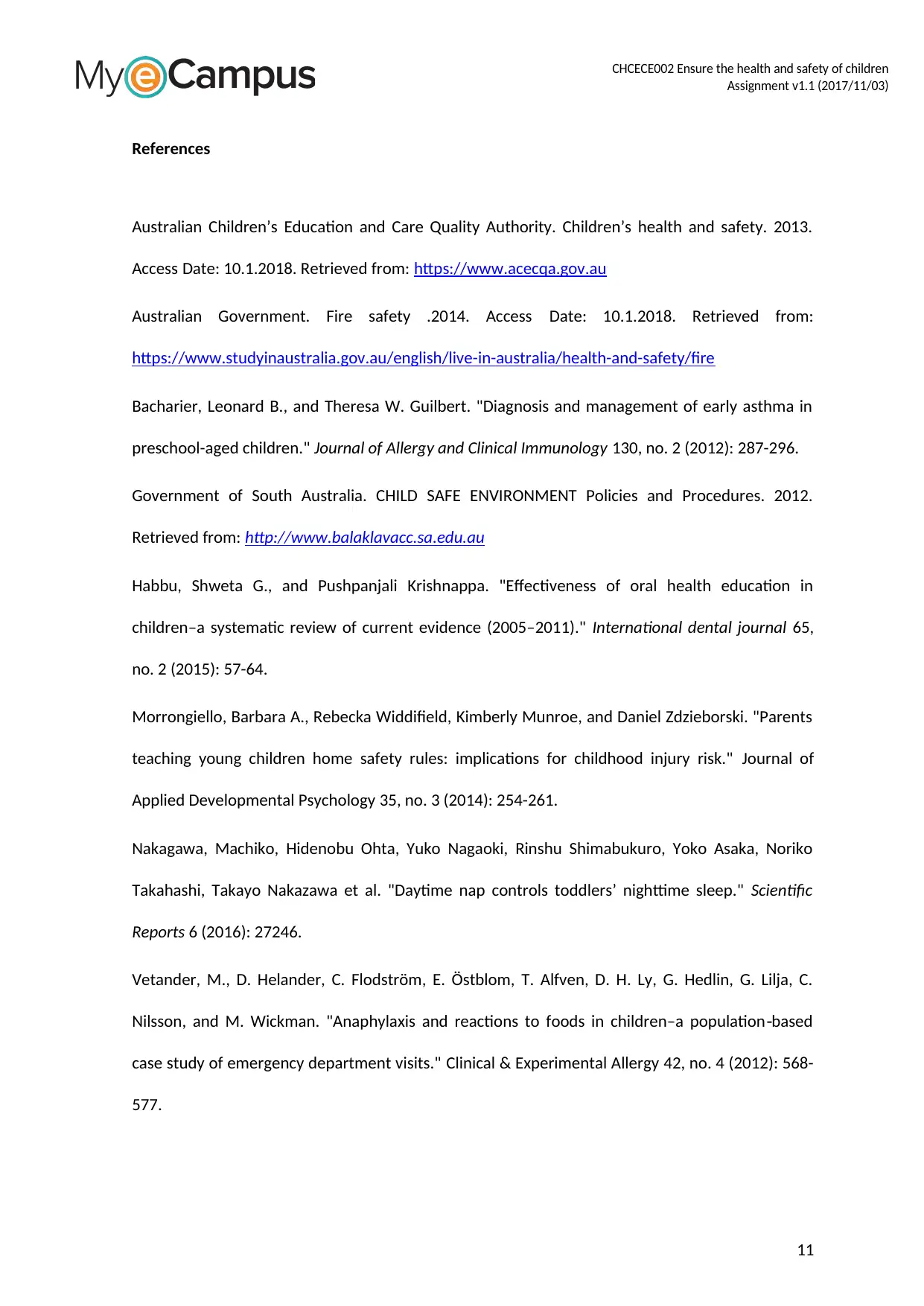
CHCECE002 Ensure the health and safety of children
Assignment v1.1 (2017/11/03)
References
Australian Children’s Education and Care Quality Authority. Children’s health and safety. 2013.
Access Date: 10.1.2018. Retrieved from: https://www.acecqa.gov.au
Australian Government. Fire safety .2014. Access Date: 10.1.2018. Retrieved from:
https://www.studyinaustralia.gov.au/english/live-in-australia/health-and-safety/fire
Bacharier, Leonard B., and Theresa W. Guilbert. "Diagnosis and management of early asthma in
preschool-aged children." Journal of Allergy and Clinical Immunology 130, no. 2 (2012): 287-296.
Government of South Australia. CHILD SAFE ENVIRONMENT Policies and Procedures. 2012.
Retrieved from: http://www.balaklavacc.sa.edu.au
Habbu, Shweta G., and Pushpanjali Krishnappa. "Effectiveness of oral health education in
children–a systematic review of current evidence (2005–2011)." International dental journal 65,
no. 2 (2015): 57-64.
Morrongiello, Barbara A., Rebecka Widdifield, Kimberly Munroe, and Daniel Zdzieborski. "Parents
teaching young children home safety rules: implications for childhood injury risk." Journal of
Applied Developmental Psychology 35, no. 3 (2014): 254-261.
Nakagawa, Machiko, Hidenobu Ohta, Yuko Nagaoki, Rinshu Shimabukuro, Yoko Asaka, Noriko
Takahashi, Takayo Nakazawa et al. "Daytime nap controls toddlers’ nighttime sleep." Scientific
Reports 6 (2016): 27246.
Vetander, M., D. Helander, C. Flodström, E. Östblom, T. Alfven, D. H. Ly, G. Hedlin, G. Lilja, C.
Nilsson, and M. Wickman. "Anaphylaxis and reactions to foods in children–a population based‐
case study of emergency department visits." Clinical & Experimental Allergy 42, no. 4 (2012): 568-
577.
11
Assignment v1.1 (2017/11/03)
References
Australian Children’s Education and Care Quality Authority. Children’s health and safety. 2013.
Access Date: 10.1.2018. Retrieved from: https://www.acecqa.gov.au
Australian Government. Fire safety .2014. Access Date: 10.1.2018. Retrieved from:
https://www.studyinaustralia.gov.au/english/live-in-australia/health-and-safety/fire
Bacharier, Leonard B., and Theresa W. Guilbert. "Diagnosis and management of early asthma in
preschool-aged children." Journal of Allergy and Clinical Immunology 130, no. 2 (2012): 287-296.
Government of South Australia. CHILD SAFE ENVIRONMENT Policies and Procedures. 2012.
Retrieved from: http://www.balaklavacc.sa.edu.au
Habbu, Shweta G., and Pushpanjali Krishnappa. "Effectiveness of oral health education in
children–a systematic review of current evidence (2005–2011)." International dental journal 65,
no. 2 (2015): 57-64.
Morrongiello, Barbara A., Rebecka Widdifield, Kimberly Munroe, and Daniel Zdzieborski. "Parents
teaching young children home safety rules: implications for childhood injury risk." Journal of
Applied Developmental Psychology 35, no. 3 (2014): 254-261.
Nakagawa, Machiko, Hidenobu Ohta, Yuko Nagaoki, Rinshu Shimabukuro, Yoko Asaka, Noriko
Takahashi, Takayo Nakazawa et al. "Daytime nap controls toddlers’ nighttime sleep." Scientific
Reports 6 (2016): 27246.
Vetander, M., D. Helander, C. Flodström, E. Östblom, T. Alfven, D. H. Ly, G. Hedlin, G. Lilja, C.
Nilsson, and M. Wickman. "Anaphylaxis and reactions to foods in children–a population based‐
case study of emergency department visits." Clinical & Experimental Allergy 42, no. 4 (2012): 568-
577.
11
1 out of 11
Your All-in-One AI-Powered Toolkit for Academic Success.
+13062052269
info@desklib.com
Available 24*7 on WhatsApp / Email
![[object Object]](/_next/static/media/star-bottom.7253800d.svg)
Unlock your academic potential
© 2024 | Zucol Services PVT LTD | All rights reserved.